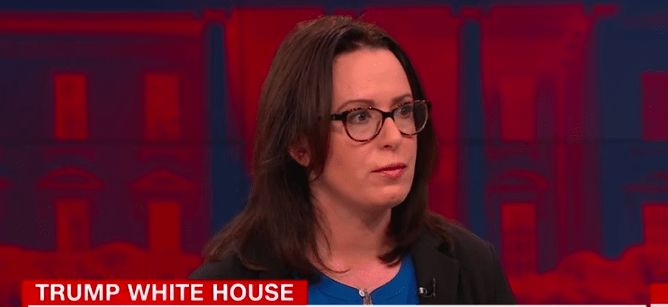Reporters Cash In White House Access for Lucrative Cable News Deals
Publications across the country may be bleeding jobs, but it’s a great time to be a reporter in D.C. Maggie Haberman, a White House reporter for The New York Times, frequently appears on CNN. (Screenshot / YouTube)
Maggie Haberman, a White House reporter for The New York Times, frequently appears on CNN. (Screenshot / YouTube)
After the 2016 elections, several publications encouraged Americans to pay for their content, framing a newspaper subscription as an act of resistance against a lying, media-bashing president.
It has paid off handsomely for legacy publications. The New York Times surpassed 500,000 new subscribers between November 2016 and April 2017, and The Washington Post told us “Democracy Dies in Darkness” and crossed the 1 million mark for paid digital subscriptions at the end of 2017.
It’s also been a financial windfall for individual White House reporters who can spin their access into lucrative side jobs as cable news analysts and speakers.
BuzzFeed News reported Monday that high-profile White House reporters can earn tens of thousands from television appearances and speaking engagements, doing so even as newspapers and websites are slashing budgets, laying off staff and shrinking the salaries of those who remain.
BuzzFeed’s Stephen Perlberg notes that while rates vary widely, “Starting contributor rates for political reporters fall between about $30,000 and $50,000 a year. Top reporters can earn between $50,000 and $90,000 for their TV side-hustles, and some seasoned pros—boosted by loyalty and multi-year arrangements—make as much as $250,000.”
Reporters who frequently appear on CNN named in the BuzzFeed article include The New York Times’ Maggie Haberman, Jonathan Martin and Julie Hirschfeld Davis, The Washington Post’s Josh Dawsey and Josh Rogin, Politico’s Rachael Bade, Time’s Molly Ball, Bloomberg’s Margaret Talev and AP’s Julie Pace. Philip Rucker, Robert Costa, David Fahrenthold and Ashley Parker from The Washington Post, The Daily Beast’s Betsy Woodruff and Gabe Sherman, and Emily Jane Fox from Vanity Fair have all appeared on NBC or MSNBC.
Others, like Axios’ Jonathan Swan, choose speaking appearances, which net Swan about $25,000 each. That’s more than half the $44,000 the average print reporter earns per year, according to the Bureau of Labor Statistics.
These boons, Perlberg writes, “stemmed, in part, from a shift in strategy by CNN President Jeff Zucker and NBC News chair Andy Lack. They were “Dinged by critics for featuring roundtables of talking heads,” and have responded with “a buying spree to sign reporters who break news to paid contributor contracts. That way, when the Washington Post or New York Times breaks a big Russia–Trump story—and they often do—their network will have exclusive access to the bylined reporter.”
The success of the bigger publications has not trickled down to newer online publications or local newspapers. In fact, the gaps between the journalism haves and have-nots is widening.
Across the country, local newspapers and online media properties alike, often owned by billionaires or hedge funds with limited experience in journalism, are cutting budgets, trimming key sections and laying off staff in an attempt to force quick profitability in an increasingly volatile industry.
Just today [May 14)], The Salt Lake City Tribune cut 34 staff members, which included, as the paper’s own Tony Semarad reported, “many well-known writers read for generations,” along with “key print sections.”
On March 14, the Denver Post’s hedge fund owner, Digital First Media, laid off a third of the paper’s newsroom staff. It made similar cuts, as the Los Angeles Times reported, to its California papers in January and February. The L.A. Times’ own staff was decimated by former owner Tronc. And, as columnist Robin Abcarian put it in an address to the Society of Professional Journalists, it used a “death-by-a-thousand-cuts” strategy “that has taken us from a robust newsroom of 1,200 to somewhere around 400.”
Last week, Gizmodo Media published an expose of its owner, Univision. The company, according to reporters Kate Conger, David Uberti and Laura Wagner, “was a tremendous golden goose laying tremendous golden eggs: It made incredible amounts of money and had to do essentially nothing for it other than run programming produced by Televisa, a Mexican broadcasting operation.”
This fairy tale, the Gizmodo writers explain, “ended long ago. Univision has been in decline for years, thanks to a disastrous private equity buyout finalized in 2007; an aging audience; a burdensome program-licensing deal with Televisa; competition from Telemundo and Netflix; layers of overpaid and useless middle management; and a general failure to position itself for a digital future.”
The Boston Consulting Group, which was retained to fix this self-created mess, reportedly recommended budget cuts of up to 35 percent in some parts of the company, in addition to the 150 people who have already been laid off. That the Gizmodo Media Group is actually profitable won’t prevent rumored cuts of up to a third of its newsroom by the end of June.
Reporters who do not benefit from cable news appearances took to Twitter to express their frustration.
Aleksander Chan of Splinter, part of the Gizmodo Media Group, tweeted: “i love knowing that it costs two (2) jonathan swan speaking engagements to hire one (1) full-time staff reporter at the union minimum salary—good and normal.” He added: “just three (3) jonathan swan speeches would get me a senior editor ABOVE the union minimum :)”
Jeff Stein of The Washington Post echoed this sentiment, tweeting: “The average reporter in the US earns $44K/year. Layoffs have been widespread at local papers. Meanwhile, @perlberg reports White House reporters are earning $50K-$90K/annually — & up to $200K! — for their TV ‘side-hustles,’ in addition to salaries.”
The reporters pocketing six-figure salaries justified their money to BuzzFeed by saying that “they work constantly and live under the threat of a morning-altering Trump tweet or an evening-altering scoop from a competitor, not to mention frequent attacks on their profession from the president and his allies.”
They conveniently ignore the irony that the same president who calls outlets that fact-check his speeches “fake news” and openly muses about taking away press credentials is actually boosting their careers.
Your support matters…Independent journalism is under threat and overshadowed by heavily funded mainstream media.
You can help level the playing field. Become a member.
Your tax-deductible contribution keeps us digging beneath the headlines to give you thought-provoking, investigative reporting and analysis that unearths what's really happening- without compromise.
Give today to support our courageous, independent journalists.








You need to be a supporter to comment.
There are currently no responses to this article.
Be the first to respond.